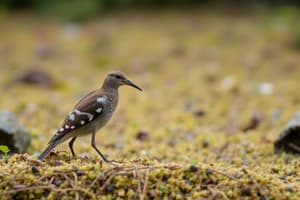Podcast
Questions and Answers
What is the goal of conservation biology?
What is the goal of conservation biology?
- Environmental sustainability
- Preserving species and ecosystems (correct)
- Political change
- Education activism
Environmentalism is solely focused on preserving species.
Environmentalism is solely focused on preserving species.
False (B)
What is the definition of biological diversity?
What is the definition of biological diversity?
The variety of life that exists
Adaptive radiation can result in very _____ rich areas.
Adaptive radiation can result in very _____ rich areas.
What are the requirements for hybrid speciation to occur?
What are the requirements for hybrid speciation to occur?
What is the biological species concept (BSC)?
What is the biological species concept (BSC)?
Match the following species concepts with their descriptions:
Match the following species concepts with their descriptions:
What does species richness refer to?
What does species richness refer to?
What are the types of species diversity mentioned?
What are the types of species diversity mentioned?
Flashcards are hidden until you start studying
Study Notes
Conservation Biology and Sustainability
- Conservation biology focuses on preserving species and ecosystems.
- Environmentalism is a movement that aims to protect the environment through political and educational activism.
- Sustainability refers to practices that can be continued indefinitely.
- Environmental sustainability focuses on the rate at which renewable resources are harvested.
Biodiversity
- Biodiversity refers to the variety of life on Earth.
- Genetic diversity is essential for preventing inbreeding depression.
- Ecosystem diversity encompasses both the variety of species across ecosystems and the variation of ecosystems within a region.
- Species diversity refers to the total range of life on Earth.
Speciation
- Traditional Speciation: One lineage diverges into two distinct lineages.
- Example: Whales and hippos.
- Phyletic speciation: One lineage undergoes gradual change over time.
- Example: Whales, Homo sapiens.
- Hybrid speciation: A new species arises from the hybridization of two parent species.
- This is uncommon because hybrid offspring must:
- Prefer to mate with other hybrids.
- Survive to reproductive age.
- Be fertile, not sterile.
- Be fit, ideally better adapted than their parent species.
- This is uncommon because hybrid offspring must:
Adaptive Radiation
- Can lead to areas with a high number of species.
- Example: Darwin's finches on the Galapagos Islands.
- Determining the evolutionary path of species within adaptive radiation can be challenging.
Ring Species
- Neighboring populations within a ring species are slightly different but can still interbreed.
- When the "ring" closes, the two end populations may no longer be able to interbreed.
Determining Biodiversity
- Species richness: the number of species in a given area.
- Alpha diversity: local diversity within a small area.
- Gamma diversity: regional diversity across a larger area.
- Beta diversity: rate of species turnover between different habitats.
Species Concepts
- Biological Species Concept (BSC): Defines species as organisms that can interbreed and produce viable offspring.
- Pros: Populations that look and act alike are likely to be the same species.
- Cons: Some species can interbreed but are considered different species. (Ex: Dogs, wolves, coyotes). Difficult to assess interbreeding in fossils or with asexual species.
- Morphological Species Concept (MSC): Organizes species based on physical similarities.
- Pros: Simple and easy to assess. Useful for fossils, asexual species, and geographically isolated species.
- Cons: Sexual dimorphism (differences between sexes) can be misleading. Cryptic species (genetically distinct, but appear identical) may be incorrectly lumped together.
Studying That Suits You
Use AI to generate personalized quizzes and flashcards to suit your learning preferences.




